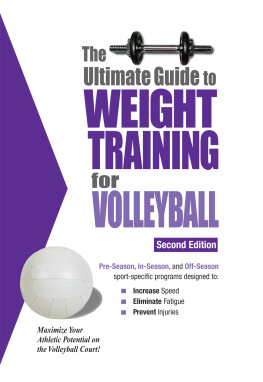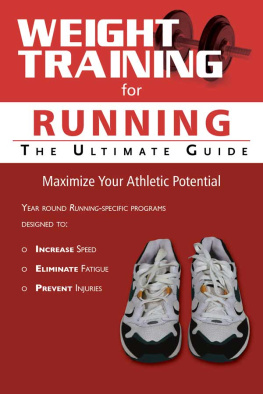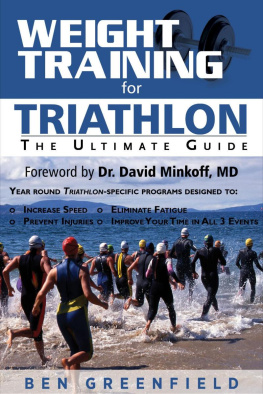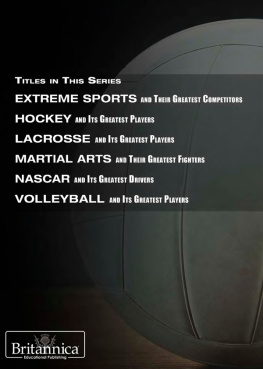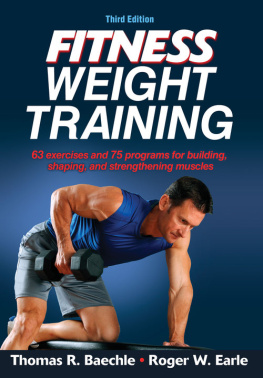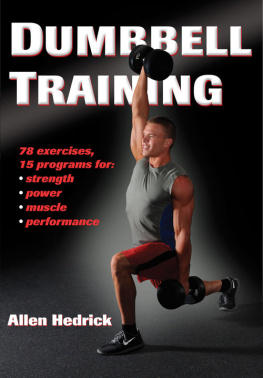The
Ultimate Guide to
WEIGHT
TRAINING
for
VOLLEYBALL
second edition
Prior to beginning any exercise program, you must consult with your physician. You must also consult your physician before increasing the intensity of your training.
Any application of the recommended material in this book is at the sole risk of the reader, and at the readers discretion. Responsibility of any injuries or other negative effects resulting from the application of any of the information provided within this book is expressly disclaimed.
Published by Price World Enterprises
28550 Belcourt Rd.
Cleveland, OH 44124
Copyright 2005 by Robert G. Price CPFT. All rights reserved. Neither this book, nor any parts within it may be sold or reproduced in any form without permission.
Book layout and typesetting by JustYourType.biz
Cover design by Alexandru Dan Georgescu
Interior photographs by Marc Gollub
Editing by Barb Greenberg
Editing and proofreading by Maryanne Haselow-Dulin
Printing by RJ Communications
Second Edition, 2005
ISBN: 978-1-936910-77-9
10 9 8 7 6 5 4 3 2
Special thanks to:
Dr. Marc B. Price CPFT for your expert insight and helpful contributions Zack, David, and Gail Price for your support and encouragement to make this book possible.

The
Ultimate Guide to
WEIGHT
TRAINING
for
VOLLEYBALL
second edition

CONTENTS
Part I

Volleyball
Specific
Training

INTRODUCTION
By opening The Ultimate Guide to Weight Training for Volleyball, you have taken your first step towards achieving your athletic potential. This book is loaded with the most up-to-date sports weight training information and features a year-round volleyball-specific weight-training program. Upon completion of the text, you will know how to properly, safely, and effectively perform over 80 exercises and you will be ready to begin your training.
The true importance of this book lies in the volleyball-specific programs in the front of the book. They were created for one reason and one reason only; to improve your volleyball-playing potential. They do this by increasing your strength, explosion, power, endurance, and flexibility in the parts of your body that are most important for volleyball. Each program has been synergistically created to supply you with the advantage you will need to beat out your teammates and to outperform your opponents. By following the programs, you will build your muscles with strength and endurance as well as explosion, power, and agility. When the season begins, you will be physically prepared and mentally ready to compete at the highest of your potential.
The programs were constructed in such a way that you will be on the top of your game the day the season starts and you will be able to maintain your strength and power throughout the season. The off-season program is set up as a two-day split, four days per week, which means you train all of your muscle groups over the course of two training sessions followed by a rest day. The off-season is where you will build your foundation of strength and power. The preseason routine is designed to further enhance your physical abilities enabling you to peak with strength and power at the onset of the season. And lastly, the in-season program is designed for the maintenance of your off-season gains without the risk of overtraining.
This book does not teach you how to play volleyball. It does not show you the best strategies to win a game, nor does it give you any tips to improve your specific skills. This book does, however, provide you with the best methods, programs, and strategies available to physically improve your body and maximize your volleyball-playing potential!
OFF-SEASON TRAINING
The off-season is the time in any sport to build up your muscles, become stronger, and more powerful. The off-season program consists of four different four-week routines cycled together to build both absolute strength and explosive power. The first and third routines are designed for you to put on size and strength while the second and fourth programs are designed for power and explosion.

Variation is one of the keys to a great workout program. The most important reason to vary your routines is so you can continue making progress and gains. Your body will eventually adapt to any routine it s on, so it is very important to change routines once your gains have stopped and your strength has peaked. Four weeks is the most effective time period to follow any one routine. For more information on the importance of variation to weight training see the section The Declaration of Variation.
STRENGTH TRAINING
The stronger the vital areas of your body are, the better off you will be. Although some muscles are more important than others, every muscle in your body needs to be well trained. Five important aspects to strength training that the book provides:
Compound exercises: Each program contains many compound exercises, that is, an exercise (such as squats, bench presses, and lat pull downs)that trains two or more muscle Groups. Most exercise and strength-training experts agree that compound exercises are the most efficient exercises for building strength and size.
Great form: For the best results, use great form while training. Take at least two seconds on the eccentric (negative) phase of the lift and at least one second on the concentric (positive) phase of the lift. This slow, rhythmic movement builds your muscles up bigger and stronger than any other type of lifting.
Pyramid Method: Several exercises in the strength-building routines are structured in a pyramid method of sets and reps, which is another strength-building tactic designed to maximize your efforts in the gym. When using the pyramid method, you decrease the reps and increase the load with every set.
55555
Heavy weights, low reps: Building strength effectively requires lifting heavy weights between 1 and 8 repetitions for each set. Working to failure with fewer reps and heavier weights is the most effective way to put on strength and size quickly. To achieve the fastest and most effective results, train your muscles with the heaviest weights possible while still using good form. In most cases, people are able to lift heavier weights with barbells than dumbbells, which is why barbell exercises dominate strength programs. For optimal results, lift weights that are at least 85%of your one rep max.
Extended rest time: By lifting such heavy weights, your muscles fatigue very quickly and need more rest time between sets than the other types of training. Generally two to five minutes between sets is ample time to rest. This rest time brings your heart rate back down closer to its resting rate so you are fully ready to complete another strenuous set with heavy weights.
Next page
